
Acacia acanthoclada, commonly known as harrow wattle, is a species of flowering plant in the family Fabaceae and is endemic to southern continental Australia. It is a low, highly branched, spreading and spiny shrub with wedge-shaped to triangular or egg-shaped phyllodes with the narrower end towards the base, and spherical heads of up to 30 flowers, and linear, spirally-coiled pods.

Acacia adoxa, commonly known as the grey-whorled wattle, is a species of flowering plant in the family Fabaceae and is endemic to north-western Australia. It is a dense, low-lying shrub with linear, more or less cylindrical phyllodes in whorls of 6 to 10, heads of golden-yellow flowers, and flat, sticky pods.

Acacia hakeoides, known colloquially as hakea wattle, hakea-leaved wattle or western black wattle, is a species of flowering plant endemic to southern Australia. It is a bushy shrub or tree with lance-shaped to linear phyllodes, racemes of bright golden-yellow flowers and more or less leathery to leathery to hard and brittle pods. It can be found growing in sandy soils in semiarid and Eucalyptus woodland in the region.

Acacia aemula is a species of flowering plant in the family Fabaceae and is endemic to the south coast of Western Australia. It is an openly-branched, often prostrate, rush-like subshrub with cylindrical to more or less flat and linear phyllodes similar to its branchlets, spherical heads of cream-coloured or golden-yellow flowers and reddish-brown, thin, paper-like or crusty pods.

Acacia applanata, also known as golden grass wattle or grass wattle, is a grasslike shrub belonging to the genus Acacia and subgenus Alatae. It is native to the south west of Western Australia.
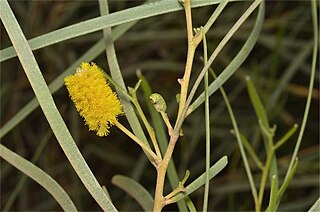
Acacia adsurgens, commonly known as whipstick wattle or sugar brother, is a species of flowering plant in the family Fabaceae and is endemic to northern areas of Australia. It is a spreading shrub with many stems, flat, linear phyllodes, densely-flowered spikes of yellow flowers, and linear, paper-like or crusty pods.

Acacia ampliata is a species of flowering plant in the family Fabaceae and is endemic to a restricted area in the south-west of Western Australia. It is a shrub or small tree with hairy branchlets, linear phyllodes, golden-coloured flowers arranged in oblong to short-cylindrical heads, and linear pods up to 110 mm (4.3 in) long.

Acacia aptaneura, commonly known as slender mulga, is a shrub belonging to the genus Acacia and the subgenus Juliflorae. It is native to central and western parts of Australia.

Acacia acanthaster is a species of flowering plant in the family Fabaceae and is endemic to the south-west of Western Australia. It is a rigid, densely-branched, domed shrub with flat, linear phyllodes, spherical heads of golden-yellow flowers, and curved pods that resemble a string of beads.
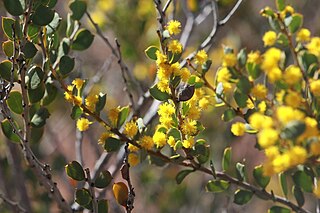
Acacia acoma is a species of flowering plant in the family Fabaceae and is endemic to inland ares of south-western Western Australia. It is an erect, spindly, open or spreading shrub with variably-shaped, often narrowly oblong phyllodes, flowers arranged in spherical heads, usually arranged in pairs in leaf axils, and strongly curved or spirally coiled pods up to 15 mm (0.59 in) long when expanded.

Acacia aculeiformis is a species of flowering plant in the family Fabaceae and is endemic to the south-west of Western Australia. It is prostrate, scrambling, mat-forming shrub with asymmetrical elliptic to narrowly elliptic phyllodes, and spherical heads of light to medium golden-yellow or yellowish-red flowers.

Acacia adinophylla is a species of flowering plant in the family Fabaceae and is endemic to a small area in the south-west of Western Australia. It is a prostrate to erect, scrambling shrub with cylindrical branchlets, narrowly wedge-shaped to lance-shaped phyllodes, flowers arranged in up to 4 spherical heads of dull golden yellow flowers, and paper-like pods.
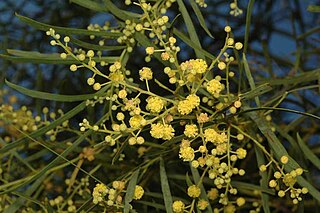
Acacia aestivalis is a species of flowering plant in the family Fabaceae and is endemic to the south-west of Western Australia. It is a bushy shrub or tree with linear to narrowly lance-shaped phyllodes, the narrower end towards the base, racemes of 5 to 11 spherical heads of golden-yellow flowers, and glabrous, papery to thinly leathery pods.
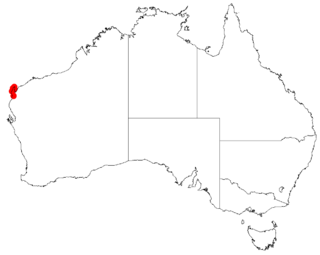
Acacia alexandri is a species of flowering plant in the family Fabaceae and is endemic to the Cape Range in the north-west of Western Australia. It is a glabrous shrub with slender branchlets, linear phyllodes, and cream-coloured flowers arranged in 1 or 2 spherical heads in the axils of phyllodes, and narrowly oblong, papery pods up to 70 mm (2.8 in) long.

Acacia amblygona, commonly known as fan wattle or fan leaf wattle, is a species of flowering plant in the family Fabaceae and is endemic to continental Australia. It is a sprawling, sometimes prostrate shrub with sharply-pointed, lance-shaped, tapering phyllodes, golden-yellow flowers arranged in a spherical head of 10 to 18 in the axils of phyllodes, and curved, coiled or twisted pods up to 70 mm (2.8 in) long.

Acacia amblyophylla is a species of flowering plant in the family Fabaceae and is endemic to an area near Shark Bay in the north-west of Western Australia. It is a bushy shrub or tree with a dense crown, many suckers, lance-shaped phyllodes with the narrower end towards the base, golden-coloured flowers arranged in spherical heads each of 24 to 26, and broadly linear to narrowly oblong pods up to 200 mm (7.9 in) long.

Acacia adenogonia is a species of flowering plant in the family Fabaceae and is endemic to northern Western Australia. It is a prickly, erect to sprawling shrub with cylindrical branchlets, egg-shaped to lance-shaped phyllodes, flowers arranged in spherical heads of golden yellow flowers, and thin leathery pods that are constricted between the seeds.
Acacia adnata is a species of flowering plant in the family Fabaceae and is endemic to a small area in the south-west of Western Australia. It is a shrub with sessile, oblong, sharply pointed phyllodes, and leathery, linear pods. The flowers are unknown.
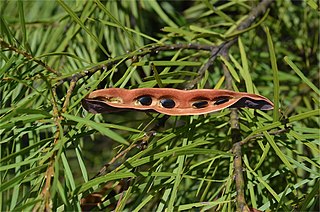
Acacia macnuttiana, commonly known as McNutt's wattle, is a flowering plant in the family Fabaceae and is endemic to north-eastern New South Wales. It is a shrub with linear phyllodes, spherical heads of bright yellow flowers arranged in racemes in leaf axils and seeds usually in more or less straight, leathery pods.
Acacia adjutrices, commonly known as convivial wattle, is a species of flowering plant in the family Fabaceae and is endemic to a few places in the south-west of Western Australia. It is a small, multi-stemmed shrub with thin stems, mostly linear, ascending to erect phyllodes, flowers arranged in up to 4 spherical heads of golden yellow flowers, and crust-like, linear to narrowly oblong pods.





















